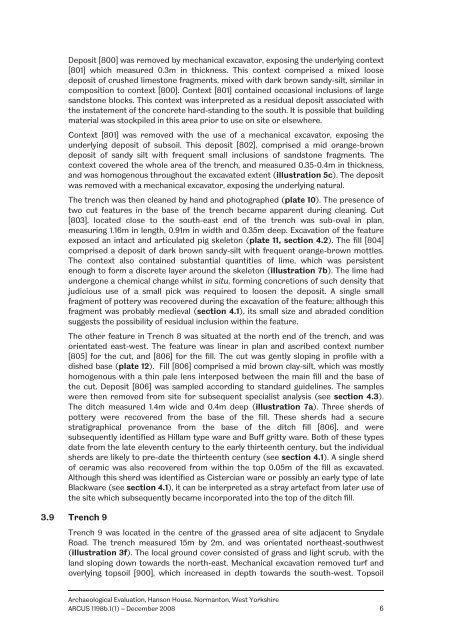Archaeological Evaluation at Hanson House, Normanton, West ...
Archaeological Evaluation at Hanson House, Normanton, West ...
Archaeological Evaluation at Hanson House, Normanton, West ...
Create successful ePaper yourself
Turn your PDF publications into a flip-book with our unique Google optimized e-Paper software.
Deposit [800] was removed by mechanical excav<strong>at</strong>or, exposing the underlying context<br />
[801] which measured 0.3m in thickness. This context comprised a mixed loose<br />
deposit of crushed limestone fragments, mixed with dark brown sandy-silt, similar in<br />
composition to context [800]. Context [801] contained occasional inclusions of large<br />
sandstone blocks. This context was interpreted as a residual deposit associ<strong>at</strong>ed with<br />
the inst<strong>at</strong>ement of the concrete hard-standing to the south. It is possible th<strong>at</strong> building<br />
m<strong>at</strong>erial was stockpiled in this area prior to use on site or elsewhere.<br />
Context [801] was removed with the use of a mechanical excav<strong>at</strong>or, exposing the<br />
underlying deposit of subsoil. This deposit [802], comprised a mid orange-brown<br />
deposit of sandy silt with frequent small inclusions of sandstone fragments. The<br />
context covered the whole area of the trench, and measured 0.35-0.4m in thickness,<br />
and was homogenous throughout the excav<strong>at</strong>ed extent (illustr<strong>at</strong>ion 5c). The deposit<br />
was removed with a mechanical excav<strong>at</strong>or, exposing the underlying n<strong>at</strong>ural.<br />
The trench was then cleaned by hand and photographed (pl<strong>at</strong>e 10). The presence of<br />
two cut fe<strong>at</strong>ures in the base of the trench became apparent during cleaning. Cut<br />
[803], loc<strong>at</strong>ed close to the south-east end of the trench was sub-oval in plan,<br />
measuring 1.16m in length, 0.91m in width and 0.35m deep. Excav<strong>at</strong>ion of the fe<strong>at</strong>ure<br />
exposed an intact and articul<strong>at</strong>ed pig skeleton (pl<strong>at</strong>e 11, section 4.2). The fill [804]<br />
comprised a deposit of dark brown sandy-silt with frequent orange-brown mottles.<br />
The context also contained substantial quantities of lime, which was persistent<br />
enough to form a discrete layer around the skeleton (illustr<strong>at</strong>ion 7b). The lime had<br />
undergone a chemical change whilst in situ, forming concretions of such density th<strong>at</strong><br />
judicious use of a small pick was required to loosen the deposit. A single small<br />
fragment of pottery was recovered during the excav<strong>at</strong>ion of the fe<strong>at</strong>ure; although this<br />
fragment was probably medieval (section 4.1), its small size and abraded condition<br />
suggests the possibility of residual inclusion within the fe<strong>at</strong>ure.<br />
The other fe<strong>at</strong>ure in Trench 8 was situ<strong>at</strong>ed <strong>at</strong> the north end of the trench, and was<br />
orient<strong>at</strong>ed east-west. The fe<strong>at</strong>ure was linear in plan and ascribed context number<br />
[805] for the cut, and [806] for the fill. The cut was gently sloping in profile with a<br />
dished base (pl<strong>at</strong>e 12). Fill [806] comprised a mid brown clay-silt, which was mostly<br />
homogenous with a thin pale lens interposed between the main fill and the base of<br />
the cut. Deposit [806] was sampled according to standard guidelines. The samples<br />
were then removed from site for subsequent specialist analysis (see section 4.3).<br />
The ditch measured 1.4m wide and 0.4m deep (illustr<strong>at</strong>ion 7a). Three sherds of<br />
pottery were recovered from the base of the fill. These sherds had a secure<br />
str<strong>at</strong>igraphical provenance from the base of the ditch fill [806], and were<br />
subsequently identified as Hillam type ware and Buff gritty ware. Both of these types<br />
d<strong>at</strong>e from the l<strong>at</strong>e eleventh century to the early thirteenth century, but the individual<br />
sherds are likely to pre-d<strong>at</strong>e the thirteenth century (see section 4.1). A single sherd<br />
of ceramic was also recovered from within the top 0.05m of the fill as excav<strong>at</strong>ed.<br />
Although this sherd was identified as Cistercian ware or possibly an early type of l<strong>at</strong>e<br />
Blackware (see section 4.1), it can be interpreted as a stray artefact from l<strong>at</strong>er use of<br />
the site which subsequently became incorpor<strong>at</strong>ed into the top of the ditch fill.<br />
3.9 Trench 9<br />
Trench 9 was loc<strong>at</strong>ed in the centre of the grassed area of site adjacent to Snydale<br />
Road. The trench measured 15m by 2m, and was orient<strong>at</strong>ed northeast-southwest<br />
(illustr<strong>at</strong>ion 3f). The local ground cover consisted of grass and light scrub, with the<br />
land sloping down towards the north-east. Mechanical excav<strong>at</strong>ion removed turf and<br />
overlying topsoil [900], which increased in depth towards the south-west. Topsoil<br />
<strong>Archaeological</strong> <strong>Evalu<strong>at</strong>ion</strong>, <strong>Hanson</strong> <strong>House</strong>, <strong>Normanton</strong>, <strong>West</strong> Yorkshire<br />
ARCUS 1198b.1(1) – December 2008 6

















